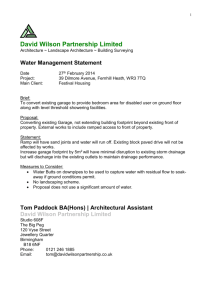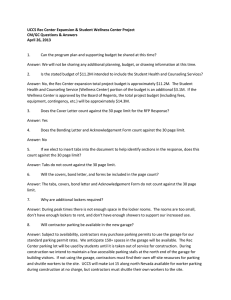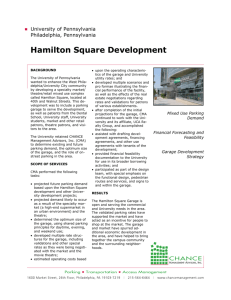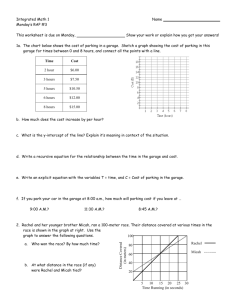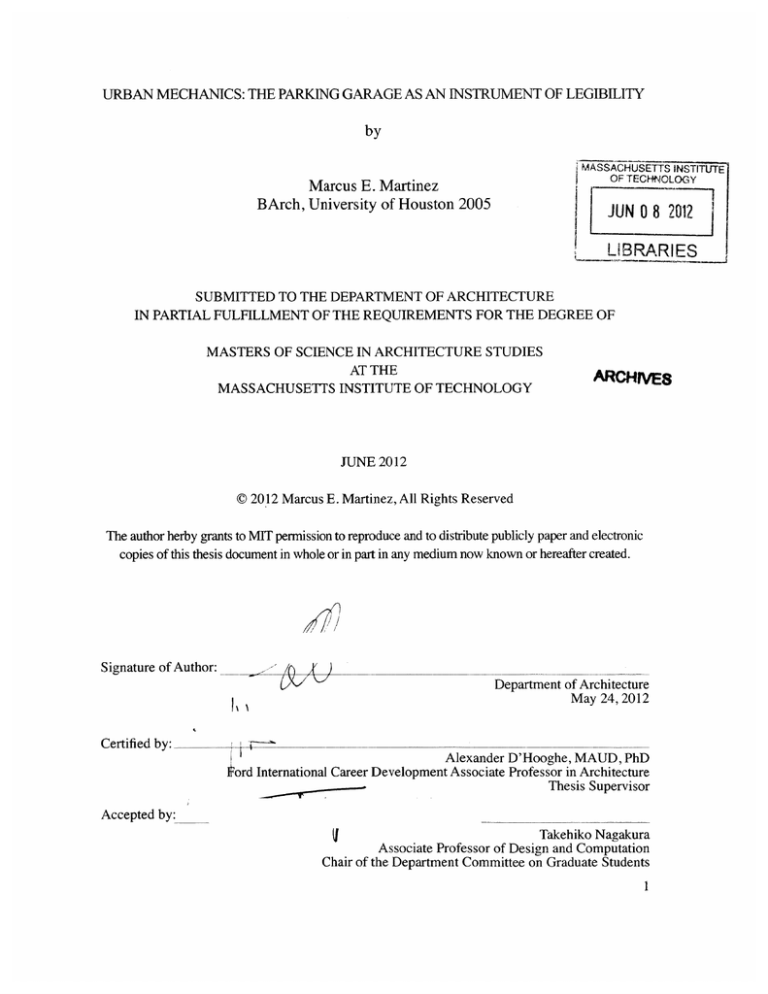
URBAN MECHANICS: THE PARKING GARAGE AS AN INSTRUMENT OF LEGIBILITY
by
MASSACHUSETTS INSTITUTE
OF TECHNIOLOGY
Marcus E. Martinez
BArch, University of Houston 2005
JUN 0 8 2012
LIBRARIES
SUBMITTED TO THE DEPARTMENT OF ARCHITECTURE
IN PARTIAL FULFILLMENT OF THE REQUIREMENTS FOR THE DEGREE OF
MASTERS OF SCIENCE IN ARCHITECTURE STUDIES
AT THE
MASSACHUSETTS INSTITUTE OF TECHNOLOGY
ARCHNVES
JUNE 2012
@ 2012 Marcus E. Martinez, All Rights Reserved
The author herby grants to MIT permission to reproduce and to distribute publicly paper and electronic
copies of this thesis document in whole or in part in any medium now known or hereafter created.
X/'1,
Signature of Author:
/)
Department of Architecture
May 24, 2012
Certified by:
Alexander D'Hooghe, MAUD, PhD
kord International Career Development Associate Professor in Architecture
Thesis Supervisor
Accepted by:
Takehiko Nagakura
Associate Professor of Design and Computation
Chair of the Department Committee on Graduate Students
1
Urban Mechanics: The Parking Garage as an Instrument for Legibility
by
Marcus E. Martinez
Submitted to the Department of Architecture on May 24, 2012 in Partial Fulfillment of
the Requirements for the Degree of Master of Science in Architecture Studies
ABSTRACT
No typology has fragmented urban space more than the parking
garage. In fact, the city of Houston's parking contingent practice
THESIS ADVISOR
Alexander D'Hooghe, MAUD, PhD
Ford International Career
Development Associate Professor
in Architecture
has a resulted in a garage on 30% of the downtown district.The
range from afew underground floors to 15 stories above ground
THESIS READER
make the garage both adefining contextual attribute and a
Professor in Architecture
Michael Dennis, BArch
testament to independently functioning sites.
This thesis speculates upon the parking garage typology as
an instrument of urban legibility and future growth. When
limited to the efficiencies of disciplinary conventions garages
are distinct facilitative structures that are site adapted anywhere
and predictably limited to the function of vehicle storage. Yet by
focussing on the immense scale, the structural language of the
garage can be configured as a structural infrastructure that can
serve beyond the needs of the vehicle and exert higher-level
roles for greater urban spaces.
Urban Mechanics
3
4
URBAN MECHANICS
THE PARKING GARAGE AS AN INSTRUMENT OF LEGIBILITY
by
Marcus E. Martinez
THESIS COMMITTEE
THESIS ADVISOR
Alexander D'Hooghe
Assistant Professor in Architeclure
THESIS READER
Michael Dennis
Professor in Architecture
Urban Mechanics
5
6
ACKNOWLEDGEMENTS
I am indebted to many of my professors and colleagues that have
supported and inspired my interest throughout my pursuits at
MIT.
I am thankful to my advisor, Alexander D'Hooghe, whose firm
guidance challenged me to develop an understanding of inquiry
and representation.
This thesis would not have been possible if not for Michael
Dennis whose advice and provocations will continue to guide
my future explorations.
I would also like to thank Kent Larson and Ryan Chin of the MIT
Media Lab for awarding me the privilege to participate in your
research and to be changed by your perspective.
I owe my deepest gratitude to my wife, Amna who remains
an inspiration for all I do. To my parents, who have always
committed to my creative interest and education.
Urban Mechanics
7
8
E P RNGGA RAGE AS AN
INS
E
O LiT
Abstrac t
Ack nvowledgeme nt s
7
AN URBAN MEDIUM-,
2AN ECOLOGY OF FLATNESS1
TOWARDS ANEW TYPOLOGY-25
KINFRASt;CTUR39
4STRUCTURAL
5FUTURE ROLES FOR THE GARAGE7
B ili)orap hy)
,7 3
Urban Mechanics
9
IMAGE: Constantin Melinkoff, 1925
01
AN URBAN MEDIUM
"Iwill build a car for the great multitude. It will be large enough for the family,
but small enough for the individual to run and care for. It will be constructed
of the best materials, by the best men to be hired, after the simplest designs
that modern engineering can devise. But it will be so low in price that no man
making a good salary will be unable to own one - and enjoy with his family
the blessing of hours of pleasure in God's great open spaces"
-
Henry Ford 1922, My Life and My Work
we must learn to see the hidden forms in the vast sprawl of our cities. We are
not accustomed to organizing and imaging an artificial environment on such
a large scale; yet our activities are pushing us towards that end."-Kevin Lynch, Imageability The Image of The City p9
When Henry Ford transformed the automobile from a novelty
of the privileged few to an affordable tool for the masses it
initiated a new pattern and pace for American modern life. By
the 1930's, over 23 million cars were in circulation on America's
roads. The automobile's spatial demand for both movement and
storage created an opportunity for revenue and expansion in city
centers and peripheries with suburban populations exceeding
the growth of urban areas by 30% in the 1950's. The result was
the adoption of the automobile that has dispersed nearly all
American cites, and continues to today.
Louis Mumford said that the "right to have access to every
Urban Mechanics
11
building in the city by private motorcar in an age where everyone
possesses such a vehicle isactually the right to destroy the city" In
contrast, historian Reyner Banham frames the notoriously mobile
city of Los Angeles in a positive light, as acity that functions less
formally. Through Banham's narrative on Los Angeles he may
have argued with the medieval Mumford that within these new
radically mobile cities, permanence istraded continuous renewal
and therefore new experiences, and types, carry a functional
specificity that escapes formal definition.
As an extension to Banham's theme of ecologies, this thesis views
the parking garage as asub-ecology of Houston, specifically in
the downtown district where the ubiquity of parking garages is
Houston's 'deep palimpsest' It has become not only a character
of the city, but a necessary integrative structure with untapped
potential for inventing new spaces and experiences through this
type. The sprawl of Houston also renders the parking garage
as a unique climate response, in which case interconnected air
conditioned sky-bridges and underground tunnels, serve to
minimally disrupt the air conditioned driving experience.
This research touches upon the garage typology as type that
has historically been subject to experimentation in circulation
and construction technique. In this thesis, the parking garage
isa spatial strategy that serves as an instrument for making an
urban structure legible .The design research proposal operates
through the typology of the parking garage which isfounded
upon internal vehicular dynamics that isthen made civilized
by mapping new patterns of movement and connections that
12
liberate the ground through a structure that anticipates future
urban program. Therefore The garage istransformed from a
neutral facilitative player to an active urban medium, that gives
to...etc etc (complete sentence with what it does and end it here)
1. Henry Ford, "My Life and Work," Public Domain Books, 2006, Kindle Edition
2. Lewis Mumford, "The Highway and the City," New Arnerican Library, 1964, p. 23
75
3. Reyner Banham, "Los Angeles: The Architecture of Four Ecologies" Harper and Row, 1971, p.
Urban Mechanics
13
FIGURE GROUND
[he280'x280'blxk structure with 50 street widths once serving
ais pathways of trade connec ting to the bayou. Today, down-/
town's oversupply of streets isslowly eroded by new mass transit
interventions like the Metro light rail, a multi-block park- Discov-~
ery Green, and beautihcation plans currently in action to land
scape curb-side parking
7
alrEL"]
V]11r[0V]
N')
!ELBII
:1A
'Lw]rm] 0101[L
3
G MM
E[P
11
[-]I-
M M1MM
VIEW -ELi
I
WI**
]N NMM
_L
9*010
i
_ ]
rEN..ow.E
0_
_LiH]
']w.EEE]E
ME--
=II
!E*EEE'
EMMEWJK]K]rL~]3
14
-
ECOLOGY OF FLATNESS
02
".wemust learn to see the hidden forms in the vast sprawl of our cities. We are
not accustomed to organizing and imaging an artificial environment on such
a large scale; yet our activities are pushing us towards that end."-Kevin Lynch, irnageability The Image of The City p9
In the condition of vast sprawl, parking and freeways embody
a mode of life that isanalogous with the growth of the city.
Traditional squares and plazas give way to the parking space as
the terminus and point of arrival within the metropolis.
Contrary to Los Angeles where the hills and'surfburbia'were
geological identities that are connected by the infrastructure of
the'autotopia'; Houston's identity isthe infrastructure enabled by
the condition of flatness. Flatness describes its overflow of water
as well as population. Itfurther expresses a disregard for hierarchy,
planning and near frictionless expansion.
Urban Mechanics
15
r----------
3,369
I
I
LLL. .j
L.L
J
I
2,698
TWENTY FEET BELOW
I
j
I
L-
Like Montreal,Minneapolis and Toronto,Houstons 7mile skybridge and tunnel system connect 95 cityblocks above and
below the street surface. These systems are a climate response to
the tripledigitheat and humidity.
Indicated inthis drawing are the undergroundpathways and retail haven that directlyconnecttoparking garages. (dashed red)
GARAGESTUNNELSANDSKYBRIDGES
16
THE GARAGE ECOLOGY
Indicated red are the above ground parking garages inthe down
town district. The finer red lines illustrate their expanded reach
through skybridges and tunnels alter the sequential experience of
the city
[I
L
][ 4 IL
IL
E
.1
iL rJ
][
I-
-1
EN
LI
]
7--L1
L7L
__
Urban Mechanics
17
PARKING GARAGE
PARKING LOT
BELOW GRADE PARKING GARAGE
18
MEEM/
L..
:'E
EE
0 iIm-6 W - Fn]
[4F il
GN-M aW
mu.an
]7
I111
1I: M1
[
LiwmmE
zu~n.. E*ME
* ]mmE.
Fin.,.
"''"
U
-i
LE-,
U
L
'UPEHE
L1.-jAW1::
r IL 7]
mr
Urban Mechanics
19
IMAGE Richard Payne 2011
20
Urban Mechanics
21
zz
~2
I!
7.
4/:
'A
'7
i~
~/ /
/
~i
/
/
A-
~.7?7/7/
i'/
K
N
7-~
7,
7~1/7
/
-AW9PFr
F
ai)
J-i
I'
.x
-7s0W0PIPIMO
/A
/av
/
7.7
I'-~
7
77'
/
7-
Q~iJING4i~bK INTO
71~N-610Ox61$T
7
.
/7
/
/
,/
/1
I,
j
7'
I
UNAPPEPIN
77,
A,
,77
1~
7;
'7
7
J
i-I
K
K~PAqkIG9?
A
/
7'>
.7
'7SI$NO TE ACOFPARI(NG. UGVI QF/ThEAALN
-THFARFA&GVOfUSIDE EffrALfiyIIFSS 4OISTRCORE
U~f~~ SITE-S.
9CO5
P SHA SfAAE
/
/
I-7''
/
.7j
JI;
7,77
~I
/
/
/7-7'
,:-
,
,7~7~7
j7
77
7'"
'+1
/7
-~
I
p,,,, ,7~7
I'
I'
Ij'
J
I
77'
77
7
977
i'
//
7'- ~'1
/ /
77' '
,'
/
~I/
/7')
-'7!
7'
i
7..
7
7
7
?
'7 / / ""7, I~ 7.
-7'-
I
/
~'
7,
-I
* 77
ii
'7
I /
KI
/
li
/
7
-'7.-
7
'7'7
7
I
7
7 7'
7
/
/7777
-7
"'-7....
/
/
-
17,2'
7'~
Urban Mechanics
J
23
WELBECK STREET GARAGE - 1970
24
TEMPLE STREET GARAGE - 1963
04
TOWARDS ANEW TYPOLOGY
MOBILITY ON DEMAND
As horses were phased out in favor of the automobile, stables
and barns were readily available for retrofit.The combined stables
across major cities of the US amounted to 1.454,000 in 1900.
These stables created a boom in employment, with owners noticing an opportunity in the delicate nature of the new vehicles built
with open carriages, that required heavy maintenance and long
term storage when not in use during the winter months. The
same population that once tended horses and repaired bicycles
now became an added value with on site amenities like service,
repair, and fueling to these vehicles. Trained staff would store
the cars on'jack stands'to save the tires, drain gasoline, or battery acid (for electric vehicles), and cover them for months at a
Urban Mechanics
25
time. The existing stable structures of mostly smaller single story
footprints struggled to accommodate the growing driving public
while housing routine services. Interventions like turntables and
elevators made upper level floors available, but made retrieval
slow and specialized, unable to keep up with demands, as in the
case of New York City Taxi fleet of 1909.
Thus, the New York Taxi Cab influenced a need for structured
ramps that quickly ascended the cars to top levels, at times
making use of sliding on greased ramps. Hybrid combinations
of ramp and elevators temporarily met the demand for faster
vehicle return. However, similar to difficulty in meeting increasing
demands in the past, compact storage methods like elevators
and robotic garages of today cannot keep up with the immediate
access demands of car oriented cities like Houston or Los Angeles.
Demand isa distinguishing factor that continues to influence the
function, size and material of the garage. In the 1900s, the demand for rapid vehicle retrieval was quite low. The automobile's
limitations in winter weather formed a need for"dead storage",
where cars were stored for extended periods of time. The strategies that are employed to efficiently move and store cars within
astructure isbetter understood as cyclical and regional (cultural)
than atypological evolution. This isin part to changes in the
automobile's dimension, transmission type, and energy source
(gas, electric, steam), which all begin to mirror regional attitudes
towards mobility, and through the garage the value of land.
26
A CONSTANTLY CHANGING TYPE
The parking garage has been profoundly transformed by building
technique, behaviors towards mobility, and the automobile industry. The garage isoverwhelmingly characterized by its vacancy
and lack of elements which make it a subject to material experimentation with sculptural cast in place concrete structures like
the Temple Street Garage by Paul Rudolph, and precast structural
screens like the Welbeck Street Garage by Michael Blampied in
1970. Between those moments however, are the ones we are
most familiar with; the sloped floors, dim lighting, shallow sections with a spatial air that cinema captures as aspace for the
perfect crime, conspiring rendezvous.
CAR CULTURE
Engineering accomplishments of automatic transmissions, knee
action suspension, and power steering rapidly increased the
adoption rate of vehicles across genders and the adoption of the
self-park model between the 1940's-1 950's. Driving in a parking
garage became reminiscent of the freeways and exit ramps that
were symbols of freedom and technology. Large spirals and arcing pathways were as much a result of afreeway culture phenomenon as it was a freeway construction adaptation.
FAST AND EXPANDABLE
The'D'Hume System'was aorganizational strategy that answered
the demand of vehicle storage within limited space, and was
proven the most efficient means of circulation versus the elevator.
Urban Mechanics
27
STANDARDIZATION
SHARED PLATFORM
VEHICLE DIMENSION
STABLES AND
BIKE REPAIR
19I3
STORAGE INCITIES
AND INWINTER MONTHS
MECHANICAL
RETROFIT
11906
28
IEi~
VEHICLE AS STRUCTURAL CATALYST
ROW
PARKING
'
NEW HAVEN
MaeVc i
PuoU
Tuouse 1959
alDumO
UNIFIED
VEHICLE
DIMENSION
WITH
STRUCTURE
LsCULPTURE
ITE CAST
BARRIER
TOSLAB
BEAM
TOCOLUMN
The gararte tepoloagy
awardedi
treedomns
of expermentation
th at alternate tormscould riot.
fIJewHaven's
1empie StreetGarage;byvirtue of sitecart
concrete blerided slab to barrtier,
and reroed themnto
colurrins and beams.
Parkingbiasis contained bythe skin Aternatively the
PlacceVictor
Hugo'garage presentsa setratnd edgeasari
elevation.
SECTIONAL DISPLAY
MODERN
EXPRESSION
FREE FACADE
f
PRECAST
LONDON
SKINwwaA1
197
CARRIE"
SLABSE
COLUMN
FREE
THOUGH
FLOORS
FREEWAY
SELF PARK MODEL INCREASES SCALE
Urban Mechanics
29
The efficiency was based on 100'x100'garage study that indicated that this ramp intervention would take 2 less parking spaces
per floor than the elevator.The'D'Hume inscribed a circular ramp
through the section of offset floors.The arced ramps structurally
framed by concrete walls afforded the operator a more panoramic view navigating between floors. Vertical expandability further
aided in it's mass adoption. In 1927 the Baker Garage in Minneapolis was atestament to the D'Hume system boasting ten floors
of parking that could be expanded another eighteen floors.
STANDARDIZATION VEHICLE INDUSTRY
The few remaining vehicle manufacturers post-depression presented the opportunity to define standards for vehicular dimension and maneuvering standards (turning radius). Narrowing the
scope and future expectations for the physical presence of vehicles created new reliable organizational constraints for parking.
Specifically, row parking became acatalyst that merged structure
to vehicle dimensions.
THE HOUSTON CONTEXT
The parking garage, an overlooked type in most urban investigations, but one which has been invested in with many inventions
of spatial configurations to building technique, deserves consideration in calibrating its needs with those of the surrounding
urban context and functions. Within the context of this research
what became particularly interesting was not only the prevalence
of the parking garage in Houston but the scale in which they
30
exist.The following pages are an index of 50 parking garages
surveyed from 4 stories to over 15 stories. As the garages assume
greater heights, they take on new roles as mechanical yards and
even big-box fitness centers.
1.Simon Henley, "The Architecture of Parking" Thames and Hudson, 2007
2. Shannon Sanders Mc Donald, "The Parking Garage- Design and Evolution of a Modern Urban Form"
ULl Urban Land Institute, 2007
Urban Mechanics
31
In
w
0
U
0
0
0
0
N
0
0
Q
M
0=
0
0
N
0
0
z
2-j
qItt
N
1t
In
L8
CONNECTION TYPES
skybridge
ADJACENT BLOCK
tunnel
ADJACENT BLOCK
CONNECTED ADJACENT
BLOCK GARAGES
. . .. . . .. . .. . . . .
. . . . . .. . .. . .. . .. . .. . . . .. . .. .
*50 GARAGES SURVEYED
36
. .. . . .. . . .. . . . . .. .. . . . . . . . . . . . . . . . . . . . . . . . .
independent
above
SAME BLOCK
adjacent
SAME BLOCK
Urban Mechanics
37
_J
<-50'
7
38
r
mm"s
05
ASTRUCTURAL INFRASTRUCTURE
This proposal focuses on the two primary conditions: overcoming
the 280x280 block structure, and fwqrnented parking which
has perpetuated each site to become suburbanized zones
each operating on their own accord. Economically this has long
strained the quality of the structure requiring a substantial portion
to be portioned to structured parking.
By combining blocks and centralizing parking specifically as an
intermodal space, surrounding blocks can be appropriated for
higher urban function, new urban grain, sequence and space.
The garage structures are re-imagined as infrastructures for future
use, but not to the sacrifice of vehicular or pedestrian movement.
Urban Mechanics
39
URBAN STRUCTURE
OBSTRUCTION
Typicalsolutions to integrate ground levelprogram
RAMPS AND FLOORS
Steep vehicular ramps intend to minimize horizontal surfaces
that cannot be programmed for parking. Maximum sloped
code compliant romps have a limited run of30' and therefore
constrain the achievable floor to floor height of garages.
INTERNAL STREETS
OBLIQUE ELEVATIONS
Broadening the connection between parking bands allows a
ramp strategy that can incorporate higher floor to floor heights
for future use. Second, thenew void becomes an instant internal
street.
The elevation ofa parking garage isunique in the way it exhibits
its section and ramped elevations. This however perpetuates
vacant elevations that offer little to define a street edge.
40
PEDESTRIAN CIRCULATION
TRADING SPACES
NEW PEDESTRIAN EDGE
At the cost of 4parking spaces per floor the ramps retreat
internally.
elevation to connect vertical circulation.
The shifted ramps create an opportunity for a pedestrian
/-1
oe,
NEW STREET NETWORK
PEDESTRIAN CONTINUITY
The new pedestrian edges enable new modes ofconnectivity
between the ground, and adjacent current and future program
Now, the parking garage has liberated the ground with internal
streets, light penetration, integrated pedestrian walkways.
Urban Mechanics
41
IMMEDIATE AND FUTURE PROGRAM
RECLAIMING THE GROUND
VARIATION IN HEIGHT
T-he newground level achieves new pathways at a scale that
attracts diversity in program.
Double height spaces are accessible from the giound level and
are accessible to adjacent garage levels.
CONTINUOUS PROGRAM
DRIVE-UP PROGRAM
42
STRUCTURE
30' TYPICAL BAY
15'STRUCTURAL BAY
STRUCTURAL SCREEN
ROOF ARTICULATION
As astructural screen the elevation can be infilled in a variety of
program. The spacing of the screen establishes a set of rules to
invent within.
Within a city core, the parking garage isthe lowest form in a
developed block. By articulating the a structural roof,the garage
communicates in a clearform, does not contribute as a heat
island,and makes itselfavailable for future program as a plug-in
structure.
Urban Mechanics
43
24'-0"
44
60'-o"
24'-0"
'0"
I
I
Urban Mechanics
45
URBANISM FROM ABOVE
The fundamental persistence of the parking garage in city centers
demonstrates an exhaustive exhibition of atype that presents
an overlooked role for the garage to communicate to the
architecture above.
As mentioned in a preceding section, the garage and its
adjacent structure come in a variety of connection types. What
isless acknowledged isthe form from above and its potential to
contribute as acomplete structure.
Acollection of garages are not unlike the spatia 4
massive European markets in the manner they generate
low urban pockets.
Completed in 2005, the renovation of Santa Catarina Market in
Barcelona by Enric Miralles BenedettaTagliabue-EMBT, presents
themes of program diversity, detail, and urb
a large scale element. Prior to its recer
was originally the Convent of Santa Maria in 1845. Only three
years later the convent was destroyed by afire. With the structure
intact, the city then converted it into the first covered market in
Barcelona. Operating nearly another 150 years the market was
failing in the early 90's and was commissioned for a renovation of
the market square.
The roof structure of the renovated Santa Catarina market
asserts the ideals of a large scale structure to (though artfully)
communicate to its enclosing urban structure above..
46
Urban Mechanics
47
Santa Catarina Market , Barcelona Spain- EMBT 2005 Photo by Naomi Schiphorst
48
IMAGE Modified byauthor from Bingmaps @ 2010 Microsoft Corporation
Urban Mechanics
49
Piazza della Republica, Florence Photo by Creative Commons
RECLAIMING TRADITIONAL SPACES
The lightrail metro stop isthe element that recaptures activity
of the ground.This proposal finds opportunity in the scale
and continuity of the garage to reclaim urban spaces through
contemporary mechanisms vehicular demand.
50
Urban Mechanics
51
52
Urban Mechanics
53
ALREADY A SUPERBLOCK
Combining blocks becomes necessary to liberate new spatial
operations. Though Main Street continues to have vehicular
~2
K
11
~I
flow through asingle lane in each direction, the concentration
of north and south bound traffic has rerouted to other streets.
Closing Bell Street has little traffic flow repercussions with limited
destinations immediately to the east.
r
LANDSCAPE
Inthis hot and humid context, landscape has afunctional value
to making an outdoor space viable and desirable. However, in this
proposal, the area of focus was on the spatial implications that
can be extracted from the garage type.
F
ii
t
i~I
r_7
U
I'm
*1
...
......
..
I
...
irE
All
-
CD
..
..
....
.....
1
-7
s
~
r
77
N/FANNIN
--MAIN---------
<UTRAVIS
BELL STREET
The new pedestrian promenade on Bell Street links the Houston
Tunnel network, Metro Platform and plaza. The North and
Southbound Red Line Lightrail platform are coplanar to the plaza
as acontinuous walking surface.
56
__~
NW94
WAWNqiwNaw
qqwrlimp
Urban Mechanics
57
co
Ln
Urban Mechanics
59
INTERLACED PROGRAM
The function of a garage isintended to be its most temporary
program. Unlike the typical garages with deep plans and shallov
sections, the narrow floor plate, access to daylight, and double
height spaces make it a far less hostile space for the individual
and create opportunity for future program.
........
....
.
..............
....
........
U,
I
62
-
Urban Mechanics
63
Fit
/
A
\
~\
r
L
I
51J
%0
Urban Mechanics
65
30
Urban Mechanics
67
0~
In
......
...
..
.........
S
0
N
05
FUTURE ROLES OF THE GARAGE
While the garages takes on an atypical hybrid, the intention
was to articulate the garage as a structural infrastructure. When
articulated as a field this isunderstood through the integrative
relationships between the program elements that create a
structure with an internal clarity for both vehicles and pedestrians
in a strategy that returns activity to the ground.
This proposal challenges the image of the garage by
reconsidering its scale as an instrument of legibility by fully
employing its form to generate future program and urban spaces.
Urban Mechanics
71
72
BIBLIOGRAPHY
Lewis Mumford, "The Highway and the City," New American Library, 1964
Reyner Banham, "Los Angeles: The Architecture of Four Ecologies" Harper and Row, 1971
Simon Henley, "The Architecture of Parking" Thames and Hudson, 2007
Lars Lerup, "After the City" MIT Press, 2000
Jonathan Bell, "Carchitecture: When the Car and The City Collide" Birkhauser, 2001
Martin Wachs and Margaret Crawford, "The Car and The City" University of Michigan Press, 1992
Shannon Sanders Mc Donald, "The Parking Garage- Design and Evolution of a Modern Urban Form"
ULI Urban Land Institute, 2007
Kazys Varnelis, "Infrastructural City - Networked Ecologies in Los Angeles" Actar, 2008
Urban Mechanics
73

